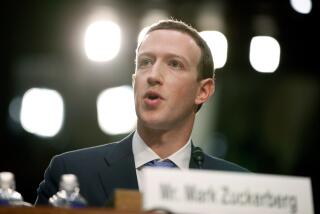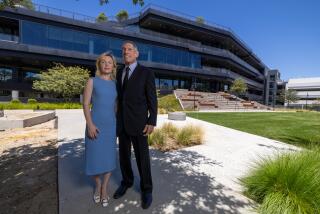Biggest Single Stanford Gift --$50 Million
- Share via
Stanford University announced Thursday that it had received a pledge of its largest gift ever from one individual--$50 million from William R. Hewlett, co-founder of Hewlett-Packard Co.
The gift--$40 million for upgrading the university’s science and engineering facilities and $10 million contingent on matching gifts for student scholarships and fellowships--will represent a substantial early start to a forthcoming fund-raising drive in celebration of the centennial of Stanford’s founding, the university announced. Stanford President Donald Kennedy said the fund drive will formally begin “in about a year--give or take a few months.”
Although larger single donations have been made to other universities, a Stanford development officer said he believes it is “the largest single gift to higher education” by an individual ever received by a California institution.
Hewlett, who is now vice chairman of the Hewlett-Packard board, explained the reason for his contribution, which comes not from the corporation or from the Hewlett foundation but from his own private resources:
“Stanford has been important to me and my family, to my company, to this community and to the nation.
“I want to see it strengthened for the future so that it will continue to benefit society through educating promising young people and performing research essential to the progress of mankind.”
Kennedy responded publicly to Hewlett’s gift by thanking the 72-year-old engineer and entrepreneur for his longstanding generosity to the university.
“Bill Hewlett, who has been a mighty benefactor over many years, has once again demonstrated immense faith in Stanford and its future.
“His commitment will support purposes that are essential to Stanford’s mission, and it will challenge others to help strengthen the university for its next century of service. We thank him from the bottom of our hearts.”
Two Years of Talks
Hewlett’s decision to pledge $40 million in direct support and $10 million in matching funds came after two years of negotiations between Kennedy and Hewlett, said William F. Dailey of Stanford’s development office.
Hewlett’s ties to Stanford go back many years, beginning in the 1930s when he received two degrees from the university, Dailey said.
Four of Hewlett’s five children have attended the university. His father taught in its medical school. And he has served for many years on the Board of Trustees.
It was during his own undergraduate days at Stanford that Hewlett met David Packard, an engineering classmate with whom he formed the partnership known as Hewlett-Packard Co. in 1939 in a garage in Palo Alto near the campus. Today the corporation is an international manufacturer of measurement and computation products and systems that employs 82,000 people worldwide.
Honorary Degrees
Over the years, Hewlett has been active in numerous organizations and has received honorary law degrees and honorary doctoral degrees from nearly a dozen colleges and universities, including Berkeley, Yale and Mills College. He has not received an honorary degree from his own alma mater, however. It is the policy of Stanford not to grant such degrees to anyone even though that has been a popular way for many universities to honor distinguished individuals and to offer thanks to their supporters.
While Hewlett’s gift may be the most substantial donation ever given to Stanford from an individual, the university is not a stranger to philanthropic generosity. Last year alone, private gift support to the university was more than $125 million--exceeded only by Harvard among major private universities.
Among the coming fund drive’s most important objectives, Kennedy said, will be the redevelopment of the university’s research facilities, the improvement of undergraduate education and the strengthening of its faculty, particularly in the humanities.
The reconstruction of the university’s research facilities is expected to cost $250 million and will cover a 41-acre site--an area larger than the original core of the campus and larger than the central campuses at Harvard or MIT, university officials said.
More to Read
Sign up for Essential California
The most important California stories and recommendations in your inbox every morning.
You may occasionally receive promotional content from the Los Angeles Times.










